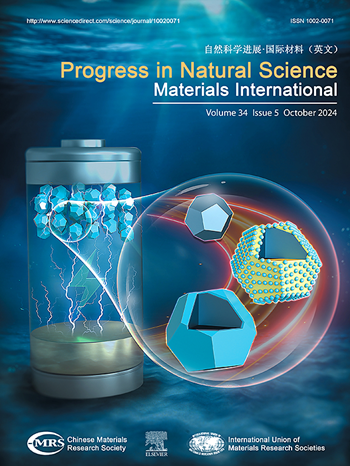Accurate prediction of pitting corrosion in aluminum alloys via integrated multi-model methods
IF 7.1
2区 材料科学
Q2 MATERIALS SCIENCE, MULTIDISCIPLINARY
Progress in Natural Science: Materials International
Pub Date : 2025-08-01
DOI:10.1016/j.pnsc.2025.03.015
引用次数: 0
Abstract
As one of the major corrosion forms of aluminum alloys in atmospheric environments, pitting corrosion is characterized by stochastic development and non-uniform progression, which challenges the accurate prediction of pitting corrosion behavior. This study employs an integrated approach combining laboratory-accelerated corrosion testing with finite element modeling (FEM) to elucidate critical environmental factors governing localized corrosion behavior. The incorporation of micro-galvanic current density parameters derived from FEM analysis demonstrates significant prediction capacity enhancement, achieving 17.9 % and 35.5 % (MAE values) improvements in pit area and depth prediction accuracy respectively compared to conventional experimental data-driven machine learning approaches. Furthermore, the developed machine learning framework enables probabilistic prediction of pit dimension distributions, establishing a holistic methodology for comprehensive early-stage pitting assessment in aluminum alloys.
基于多模型集成的铝合金点蚀准确预测
点蚀是铝合金在大气环境中的主要腐蚀形式之一,其发展具有随机性和非均匀性,这给点蚀行为的准确预测带来了挑战。本研究采用实验室加速腐蚀试验与有限元建模(FEM)相结合的综合方法来阐明控制局部腐蚀行为的关键环境因素。与传统的实验数据驱动的机器学习方法相比,结合FEM分析得出的微电流密度参数的预测能力显著增强,坑面积和深度的预测精度分别提高了17.9%和35.5% (MAE值)。此外,开发的机器学习框架能够对坑尺寸分布进行概率预测,为铝合金的综合早期点蚀评估建立了一个整体方法。
本文章由计算机程序翻译,如有差异,请以英文原文为准。
求助全文
约1分钟内获得全文
求助全文
来源期刊
CiteScore
8.60
自引率
2.10%
发文量
2812
审稿时长
49 days
期刊介绍:
Progress in Natural Science: Materials International provides scientists and engineers throughout the world with a central vehicle for the exchange and dissemination of basic theoretical studies and applied research of advanced materials. The emphasis is placed on original research, both analytical and experimental, which is of permanent interest to engineers and scientists, covering all aspects of new materials and technologies, such as, energy and environmental materials; advanced structural materials; advanced transportation materials, functional and electronic materials; nano-scale and amorphous materials; health and biological materials; materials modeling and simulation; materials characterization; and so on. The latest research achievements and innovative papers in basic theoretical studies and applied research of material science will be carefully selected and promptly reported. Thus, the aim of this Journal is to serve the global materials science and technology community with the latest research findings.
As a service to readers, an international bibliography of recent publications in advanced materials is published bimonthly.

 求助内容:
求助内容: 应助结果提醒方式:
应助结果提醒方式:


